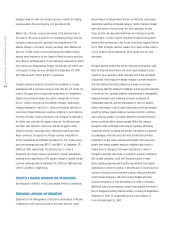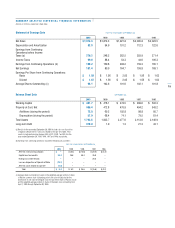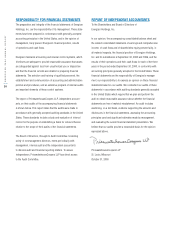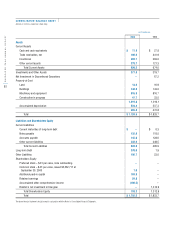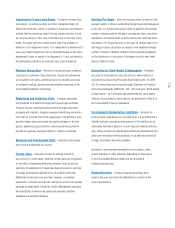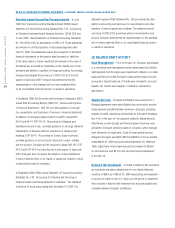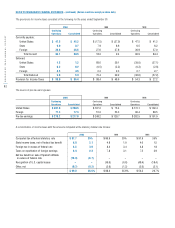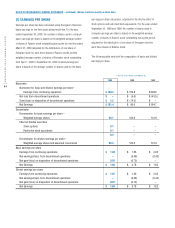Energizer 2000 Annual Report Download - page 28
Download and view the complete annual report
Please find page 28 of the 2000 Energizer annual report below. You can navigate through the pages in the report by either clicking on the pages listed below, or by using the keyword search tool below to find specific information within the annual report.
ENERGIZER 2000 ANNUAL REPORT
26
For foreign operations where the U.S. dollar is the functional currency
and for countries which are considered highly inflationary, transla-
tion practices differ in that inventories, properties, accumulated
depreciation and depreciation expense are translated at historical
rates of exchange, and related translation adjustments are included
in earnings. Gains and losses from foreign currency transactions
are generally included in earnings.
Financial Instruments
– Energizer uses financial derivatives in
the management of foreign currency and interest-rate risks that are
inherent to its business operations. Such instruments are not held
or issued for trading purposes.
Foreign exchange (F/X) instruments, including currency forwards,
purchased options and zero-cost option collars, are used primarily
to reduce transaction exposures associated with anticipated inter-
company purchases and intercompany borrowings and, to a lesser
extent, to manage other transaction and translation exposures.
F/X instruments used are selected based on their risk reduction
attributes and the related market conditions. The terms of such
instruments are generally 12 months or less.
Realized and unrealized gains and losses from F/X instruments
that hedge firm commitments are deferred as part of the cost basis
of the asset or liability being hedged and are recognized in the
Consolidated Statement of Earnings in the same period as the
underlying transaction. Realized and unrealized gains or losses from
F/X instruments used as hedges of existing balance sheet exposures
or anticipated transactions that are not firmly committed are recog-
nized currently in selling, general and administrative expenses in the
Consolidated Statement of Earnings. However, gains or losses from
F/X instruments that hedge existing balance sheet exposures are
offset in the Consolidated Statement of Earnings by gains or losses
recorded on these hedged exposures. Premiums or discounts on
foreign exchange forward contracts are recognized, and premiums
paid for purchased options are amortized, over the life of the related
F/X instrument in selling, general and administrative expenses in
the Consolidated Statement of Earnings. Unrealized gains and
losses, if any, on zero-cost option collars are deferred as part of the
cost basis of the asset or liability being hedged. F/X instruments are
generally not disposed of prior to settlement date; however, if an F/X
instrument and the underlying hedged transaction were disposed
of prior to the settlement date, any deferred gain or loss would be
recognized immediately in the Consolidated Statement of Earnings.
Cash Equivalents
– For purposes of the Consolidated Statement
of Cash Flows, cash equivalents are considered to be all highly
liquid investments with a maturity of three months or less when
purchased.
Inventories
– Inventories are valued at the lower of cost or market,
with cost generally being determined using average cost or the
first-in, first-out (FIFO) method.
Capitalized Software Costs
– Capitalized software costs are
included in Investments and Other Assets. These costs are amortized
using the straight-line method over periods of related benefit rang-
ing from three to seven years.
Property at Cost
– Expenditures for new facilities and expendi-
tures that substantially increase the useful life of property, including
interest during construction, are capitalized. Maintenance, repairs
and minor renewals are expensed as incurred. When property is
retired or otherwise disposed of, the related cost and accumulated
depreciation are removed from the accounts and gains or losses
on the disposition are reflected in earnings.
Depreciation
– Depreciation is generally provided on the
straight-line basis by charges to costs or expenses at rates based
on the estimated useful lives. Estimated useful lives range from
three to 25 years for machinery and equipment and 10 to 50 years
for buildings. Depreciation expense was $57.9, $68.4 and $74.1
in 2000, 1999 and 1998, respectively.
Goodwill and Other Intangible Assets
– Amortization of
goodwill, representing the excess of cost over the net tangible assets
of acquired businesses, is recorded on a straight-line basis primarily
over a period of 25 years, with some amounts being amortized over
40 years. The cost to purchase or develop other intangible assets,
which consist primarily of patents, tradenames and trademarks, is
amortized on a straight-line basis over estimated periods of related
benefit ranging from seven to 40 years.
NOTES TO CONSOLIDATED FINANCIAL STATEMENTS – (continued) (Dollars in millions except per share data)




